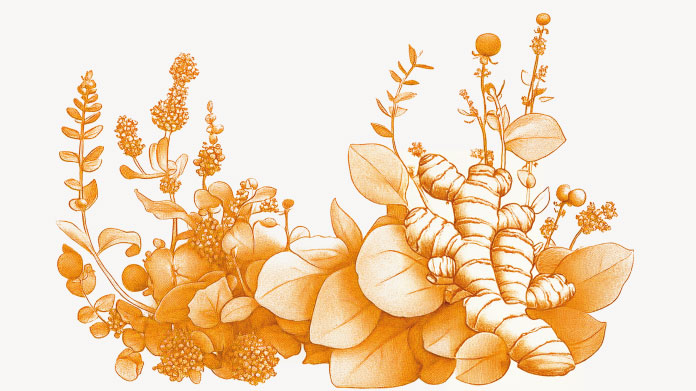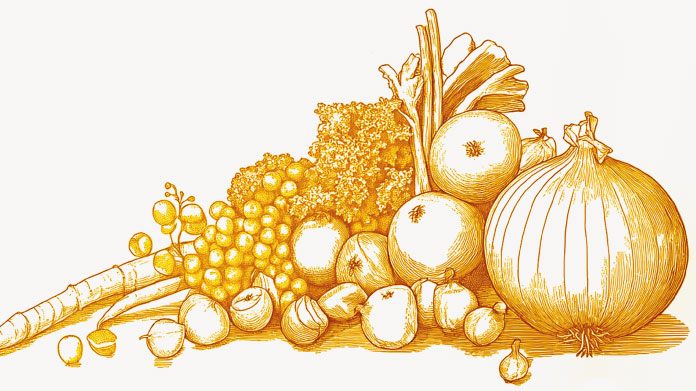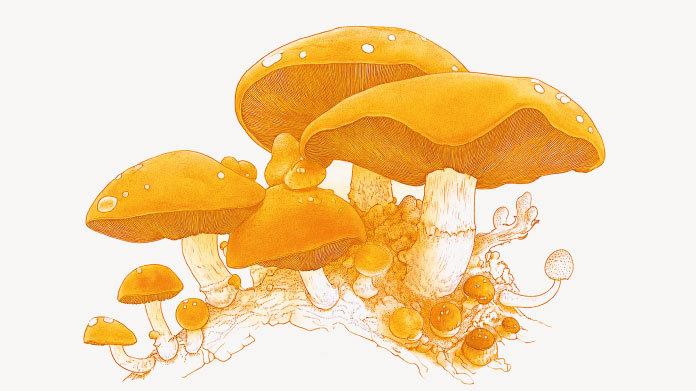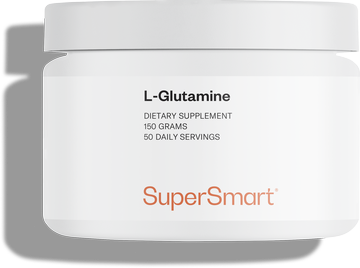Sore throat: 10 natural supplements and remedies
Scratchy, dry, burning: a raging sore throat feels relentlessly painful. Here are 10 tips and substances to help make it go away.

What exactly do we mean by a sore throat?
A sore throat affects the upper airways, or more specifically, the tonsils and pharynx. It usually manifests in painful sensations like scratchiness, burning or scraping (as if with razor blades). It’s often accompanied by difficulty swallowing, hoarseness or redness at the back of the throat.
There are many possible causes. While it’s often a symptom of a viral or bacterial infection(1), a sore throat may also just be a sign of irritation (2) caused by:
- air pollution ;
- low atmospheric humidity;
- exposure to fans and air conditioners ;
- allergy ;
- smoking ;
- inhaling toxic vapours ;
- a foreign body lodged in the upper airways;
- untreated acid reflux.
Be sure to consult your doctor if your symptoms persist or increase (fever, cough, etc).
Hot drinks, to relieve the throat with warmth
Though we might instinctively reach for something cold to fight the fire of a sore throat, hot drinks may be a better option (3). Heat actually soothes irritated mucous membranes and thins down the nasal or bronchial secretions that often accompany them.
Vegetable broths, or herbal teas with a touch of soothing honey (4) are both good options. A special mention here for tea made with common thyme, which supports anti-bacterial activity, and Breckland thyme, which supports respiratory health (5-6).
Peppermint, for soothing the mouth and throat
Since ancient times,peppermint has been one of the most popular essential oils for its refreshing and invigorating properties. It is also has remarkable applications for soothing the mouth and throat(7).
If you’re not comfortable using aromatherapy (with its delicate dilutions), ready-to-use supplements are available that contain safe doses of peppermint (Organic Defense Mix, for example, combines the best essential oils for supporting health, including peppermint, lemon, oregano and cinnamon) (8-9).
A clay or lemon poultice, the DIY remedy for a sore throat
Looking for a traditional home remedy to relieve your painful throat? Soak a thin cloth in hot lemon juice to which you’ve added a handful of coarse grey salt. Apply to your neck and let it sit there for an hour.
If your lymph nodes are swollen, a green clay poultice may be just the job (10). Apply sparingly to affected areas and cover with a thin cloth. Leave to work for 2 hours, then repeat if necessary.
Common butterbur, for seasonal hypersensitivities
A member of the Asteraceae family, common butterbur (Petasites hybridus) has featured among European medicinal plants since the Middle Ages. Containing two major active principles, petasin and isopetasin, butterbur was the subject of renewed interest in the 1950s for its potential over the spring and summer months – when there’s a significant increase in allergens (11).
As it contains naturally toxic compounds called pyrrolizidine alkaloids, make sure you opt for reliable Petasites hybridus supplements where these compounds have been removed (such as Butterbur Extract, standardized to 15% petasin and isopetasin for maximum efficacy) (12).
To moderate your response to allergens, it’s also worth considering a ‘combo’ supplement (such as Aller Fight, which also contains astragalus, an immune system-regulator, and maritime pine, which supports respiratory health) (13-14).
Humidify your home to combat dryness of the throat
Without sufficient moisture, the walls of the throat feel under attack and become dry and irritated (15). Installing a humidifier in your living room (or simply placing a bowl of water on a radiator) as soon as you start to feel any discomfort can provide some relief.
Propolis, the soothing, beehive balm
A resinous substance produced by bees to increase the hive’s resistance to contaminants, propolis has become widely available in the form of soothing throat sprays, which also help maintain oral hygiene (16).
It’s worth knowing that several types of propolis are produced across the world with different compositions depending on the biotope. Gathered from the heart of the lush forests of Brazil, green propolis (featured in the powerful supplement Green Propolis) is exceptionally rich in cinnamic acid, kaempferol, and artepillin C, hence the growing interest in its therapeutic potential (17).
When it’s impossible to swallow - gargle
If you’re finding it difficult to swallow, try gargling several times a day with a natural antiseptic (such as salt, lemon juice, bicarbonate of soda or a little aspirin) diluted in a glass of warm water(18).
Keep the liquid at the back of the throat for 30 seconds (tipping your head back), then spit it out.
Purple coneflower, the flower for the upper airways
With its beautiful pink petals, purple coneflower(Echinacea purpurea) would seem to be the top plant choice of Native Americans. It offers healing effects, and supports the health of the upper respiratory tract as well as immunity(19).
As a result, this super-plant features in supplements formulated to boost the body’s natural defenses (such as Immunity Booster, containing organic echinacea enriched with vitamin C and zinc, both of which support healthy immune system function) (20-21).
Change your toothbrush regularly
When did you last replace your toothbrush? If you’re suffering with a persistent or recurrent sore throat, an old toothbrush could be the reason.
With repeated brushing, bacteria accumulate in the bristles and re-enter the body with ease (22). If your toothbrush is more than three months old, it’s definitely time to replace it.
Suck throat lozenges
Formulated from analgesics and/or local anaesthetics, throat lozenges also encourage salivation(23). At the same time as lubricating oral mucous membranes, saliva - rich in enzymes and proteins - creates a protective barrier against pathogens. A very good reason to increase your salivation!
References
- Tanz RR. Sore Throat. Nelson Pediatric Symptom-Based Diagnosis. 2018:1–14.e2. doi: 10.1016/B978-0-323-39956-2.00001-7. Epub 2017 May 12. PMCID: PMC7152117.
- Chan TV. The patient with sore throat. Med Clin North Am. 2010 Sep;94(5):923-43. doi: 10.1016/j.mcna.2010.06.001. PMID: 20736104; PMCID: PMC7094485.
- Sanu A, Eccles R. The effects of a hot drink on nasal airflow and symptoms of common cold and flu. 2008 Dec;46(4):271-5. PMID: 19145994.
- Abuelgasim H, Albury C, Lee J. Effectiveness of honey for symptomatic relief in upper respiratory tract infections: a systematic review and meta-analysis. BMJ Evid Based Med. 2021 Apr;26(2):57-64. doi: 10.1136/bmjebm-2020-111336. Epub 2020 Aug 18. PMID: 32817011.
- Fani M, Kohanteb J. In Vitro Antimicrobial Activity of Thymus vulgaris Essential Oil Against Major Oral Pathogens. J Evid Based Complementary Altern Med. 2017 Oct;22(4):660-666. doi: 10.1177/2156587217700772. Epub 2017 Apr 11. PMID: 28397552; PMCID: PMC5871273.
- Patil SM, Ramu R, Shirahatti PS, Shivamallu C, Amachawadi RG. A systematic review on ethnopharmacology, phytochemistry and pharmacological aspects of Thymus vulgaris Linn. Heliyon. 2021 May 18;7(5):e07054. doi: 10.1016/j.heliyon.2021.e07054. PMID: 34041399; PMCID: PMC8141878.
- Li Y, Liu Y, Ma A, Bao Y, Wang M, Sun Z. In vitro antiviral, anti-inflammatory, and antioxidant activities of the ethanol extract of Mentha piperita Food Sci Biotechnol. 2017 Nov 30;26(6):1675-1683. doi: 10.1007/s10068-017-0217-9. PMID: 30263705; PMCID: PMC6049716.
- Leyva-López N, Gutiérrez-Grijalva EP, Vazquez-Olivo G, Heredia JB. Essential Oils of Oregano: Biological Activity beyond Their Antimicrobial Properties. 2017 Jun 14;22(6):989. doi: 10.3390/molecules22060989. PMID: 28613267; PMCID: PMC6152729.
- Nabavi SF, Di Lorenzo A, Izadi M, Sobarzo-Sánchez E, Daglia M, Nabavi SM. Antibacterial Effects of Cinnamon: From Farm to Food, Cosmetic and Pharmaceutical Industries. 2015 Sep 11;7(9):7729-48. doi: 10.3390/nu7095359. PMID: 26378575; PMCID: PMC4586554.
- Williams LB, Haydel SE. Evaluation of the medicinal use of clay minerals as antibacterial agents. Int Geol Rev. 2010 Jul 1;52(7/8):745-770. doi: 10.1080/00206811003679737. PMID: 20640226; PMCID: PMC2904249.
- Thomet OA, Schapowal A, Heinisch IV, Wiesmann UN, Simon HU. Anti-inflammatory activity of an extract of Petasites hybridus in allergic rhinitis. Int Immunopharmacol. 2002 Jun;2(7):997-1006. doi: 10.1016/s1567-5769(02)00046-2. PMID: 12188041.
- Avula B, Wang YH, Wang M, Smillie TJ, Khan IA. Simultaneous determination of sesquiterpenes and pyrrolizidine alkaloids from the rhizomes of Petasites hybridus (L.) G.M. et Sch. and dietary supplements using UPLC-UV and HPLC-TOF-MS methods. J Pharm Biomed Anal. 2012 Nov;70:53-63. doi: 10.1016/j.jpba.2012.05.021. Epub 2012 Jun 5. PMID: 22809670.
- Zheng Y, Ren W, Zhang L, Zhang Y, Liu D, Liu Y. A Review of the Pharmacological Action of Astragalus Polysaccharide. Front Pharmacol. 2020 Mar 24;11:349. doi: 10.3389/fphar.2020.00349. PMID: 32265719; PMCID: PMC7105737.
- Iravani S, Zolfaghari B. Pharmaceutical and nutraceutical effects of Pinus pinaster bark extract. Res Pharm Sci. 2011 Jan;6(1):1-11. PMID: 22049273; PMCID: PMC3203267.
- Renner B, Mueller CA, Shephard A. Environmental and non-infectious factors in the aetiology of pharyngitis (sore throat). Inflamm Res. 2012 Oct;61(10):1041-52. doi: 10.1007/s00011-012-0540-9. Epub 2012 Aug 14. PMID: 22890476; PMCID: PMC3439613.
- Di Pierro F, Zanvit A, Colombo M. Role of a proprietary propolis-based product on the wait-and-see approach in acute otitis media and in preventing evolution to tracheitis, bronchitis, or rhinosinusitis from nonstreptococcal pharyngitis. Int J Gen Med. 2016 Nov 11;9:409-414. doi: 10.2147/IJGM.S118967. PMID: 27956842; PMCID: PMC5113938.
- Machado JL, Assunção AK, da Silva MC, Dos Reis AS, Costa GC, Arruda Dde S, Rocha BA, Vaz MM, Paes AM, Guerra RN, Berretta AA, do Nascimento FR. Brazilian green propolis: anti-inflammatory property by an immunomodulatory activity. Evid Based Complement Alternat Med. 2012;2012:157652. doi: 10.1155/2012/157652. Epub 2012 Dec 19. PMID: 23320022; PMCID: PMC3541042.
- Tiong V, Hassandarvish P, Bakar SA, Mohamed NA, Wan Sulaiman WS, Baharom N, Abdul Samad FN, Isahak I. The effectiveness of various gargle formulations and salt water against SARS-CoV-2. Sci Rep. 2021 Oct 15;11(1):20502. doi: 10.1038/s41598-021-99866-w. PMID: 34654867; PMCID: PMC8519917.
- Lim TK. Echinacea purpurea. Edible Medicinal And Non-Medicinal Plants. 2013 Sep 3:340–71. doi: 10.1007/978-94-007-7395-0_23. PMCID: PMC7121736.
- Carr AC, Maggini S. Vitamin C and Immune Function. Nutrients. 2017 Nov 3;9(11):1211. doi: 10.3390/nu9111211. PMID: 29099763; PMCID: PMC5707683.
- Wessels I, Maywald M, Rink L. Zinc as a Gatekeeper of Immune Function. 2017 Nov 25;9(12):1286. doi: 10.3390/nu9121286. PMID: 29186856; PMCID: PMC5748737.
- Naik R, Ahmed Mujib BR, Telagi N, Anil BS, Spoorthi BR. Contaminated tooth brushes-potential threat to oral and general health. J Family Med Prim Care. 2015 Jul-Sep;4(3):444-8. doi: 10.4103/2249-4863.161350. PMID: 26288790; PMCID: PMC4535112.
- McNally D, Simpson M, Morris C, Shephard A, Goulder M. Rapid relief of acute sore throat with AMC/DCBA throat lozenges: randomised controlled trial. Int J Clin Pract. 2010 Jan;64(2):194-207. doi: 10.1111/j.1742-1241.2009.02230.x. Epub 2009 Oct 22. PMID: 19849767; PMCID: PMC7202229.
Keywords
2 Days
Reputable companysearch and the number of…
The research and the number of selection of products.
NAKHJAVAN Shervin
15 Days
The Anti Aromatase is a great product
The Anti Aromatase is a great product. You just need to have constant inventory. Recently this product has been out of stock.
GEORGE Verne
16 Days
Great help on chat
Great help on chat. Knowledgeable and friendly.
Jason Argos
20 Days
Customer service was fast and friendly.
Customer service helped to stop the transaction process of the subscription. I appreciated that.
Greenie
20 Days
I order here due to the high quality of…
I order here due to the high quality of the products and the quick delivery of items - thank you
Barbara J
21 Days
SuperSmart's Eye Pressure supplements: highly recommended!
I purchase SuperSmart's Eye Pressure supplements regularly for over 5 years, and gotta say they are truly a wonderful product for my Glaucoma. Highly recommended if you have eye pain from your Glaucoma.
D. Martinez
26 Days
Quick service
Quick service
MONELL
27 Days
Speedy service.
Speedy service.
ROSENTHAL Marvin
30 Days
Clear website- Efficient
Clear website. Excellent search engine and fast delivery!
Mohamad Hussein
33 Days
They have great products.
They have great products.
Vickie
33 Days
Great Shipping Time!
You Have A Great Shipping Time! Praise The Lord!
DMHoge
35 Days
Doctor Recommended!
Good pricing, very good availability, doctor recommended (couldn't find what I needed anywhere else), and it took only a week to arrive (which I can't complain about).
Al
36 Days
Great product and fast shipping
Great product and fast shipping
Marie
37 Days
New customer 1
I got my order fast and on time.
SA
37 Days
Great Service
Fast, good communication, as promised.
Juli





